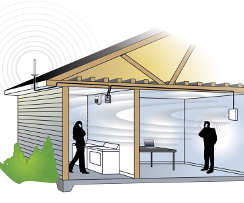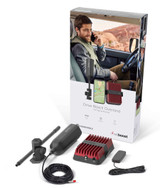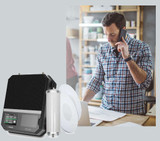4G LTE 700 Signal Booster Test Case Study

Tests Show Wilson Signal Boosters Maximize
4G Speeds in Buildings
(Originally Published by Wilson Electronics)
When Wilson Electronics, manufacturer of North America’s top-selling line of cellular signal boosters, released its 4G LTE 700 booster for devices operating on the Verizon Wireless™ LTE network, Jerome Hansen wanted to know how well the new booster could perform.
Hansen, of AlternativeWireless.com, a San Antonio-based Wilson Authorized Reseller, had good reason to check out the 4G LTE 700. He uses a Verizon 4G phone, and though the Verizon LTE service outside his house is good, the building’s metal roof inhibited the signal and made 4G coverage inside the home spotty and data speeds slow.
“I had to stand next to a window just to use the Web on my phone,” Hansen said of the slow data rates inside his home.
He resolved to use his house as a test case for the 4G LTE 700, to see if the booster could live up to the claims of faster data speeds made by Wilson.
TESTING
Hansen installed the 4G LTE 700 booster along with a Wilson 301202 Building Mount Outside Antenna installed on his roof and connected to the 4G LTE 700 with 30 feet of Wilson 400 low loss coax cable. For an inside antenna he used a Wilson ceiling mounted 301121 Dome Antenna connected by 75 feet of Wilson 400 coax.
Then, with the 4G LTE 700 booster powered off, Hansen took baseline data speed readings at three locations inside his home. He used his Samsung Droid Charge 4G phone for the tests and SpeedTest.net Mobile to measure data speeds.
Directly under the inside antenna his Droid Charge was unable to access the Verizon LTE signal. Instead the phone defaulted to the 3G signal, which it uses when no 4G signal is available. Hansen recorded a download rate of 1.8 Mbps and upload rate of 0.999 Mbps.
Moving to a second location 15 feet away from the inside antenna, and again with access only to Verizon 3G signal, he saw a 0.8 Mbps download and 0.9 Mbps upload rate.
Finally, in a third location 30 feet from the inside antenna Hansen got an LTE signal, but data rates were still far below 4G speeds at 1.3 Mbps download and 0.6 Mbps upload.
RESULTS

He then powered on the Wilson 4G LTE 700, turned the adjustable gain dials (one for uplink gain, another for downlink gain) to their highest setting, and took readings again in all three locations to measure the improvement the booster provided.
In test location 1, Hansen now could access Verizon LTE signal rather than the 3G signal he got previously. His data speeds measurements jumped 850 percent to 17.1 Mbps download, and almost 500 percent to 5.9 Mbps upload!
In test location 2 with the booster powered on, he again got 4G LTE signal rather than 3G. This produced speeds of 19.5 Mbps download (over 2,300 percent faster) and 7.1 Mbps upload (almost 700 percent faster).
Test location 3 showed data speeds of 19.7 Mbps download (a speed increase of more than 1,400 percent) and 6.7 Mbps upload (more than 1,000 percent increase).
CONCLUSION
Clearly in Hansen’s tests the Wilson 4G LTE 700 delivered dramatically faster data transfer speeds than were available without the booster. By providing a strong, reliable LTE signal inside the house, the booster allowed access to 4G speeds.
“There wasn’t that much difference in signal strength over the 3G signal,” he said. “The real difference was being able to get a reliable 4G signal that moves data so much faster.”
Hansen also noted that the increase in data speeds he observed will not be possible in every situation.
“The most important thing is the strength of the outside signal,” he said. “We have a pretty strong Verizon signal outside the building. If you have a strong signal outside, then you can have faster data speeds inside.”
Recent Posts
-
weBoost Overland Signal Booster For Rugged, Off-Road Adventure
The New weBoost Drive Reach Overland The weBoost new Drive Reach Overland is the ideal booster fo …Dec 02, 2022 -
The New weBoost Signal Booster Set Up App
Installing Your weBoost Signal Booster System Just Got Easier weBoost has released a new app to he …May 20, 2022 -
The New weBoost INSTALLED Office Signal Booster System
Get A Signal Booster System - Installed At Your BusinessOffices . Retail Store …Nov 18, 2021



